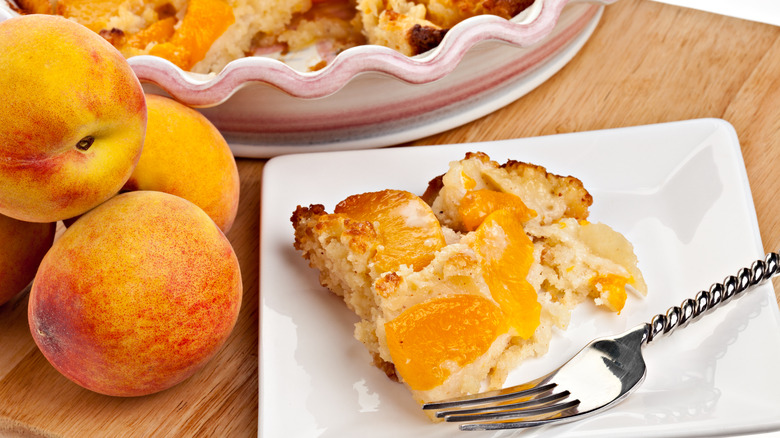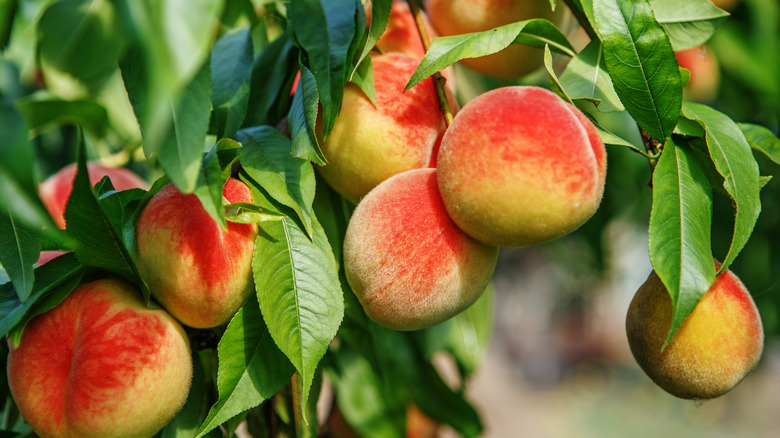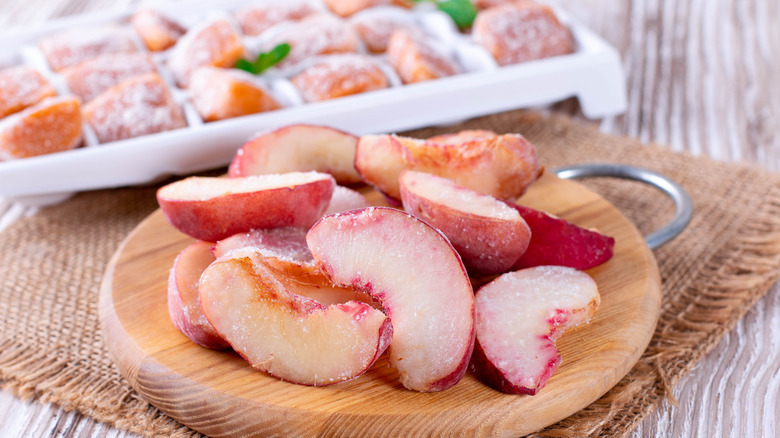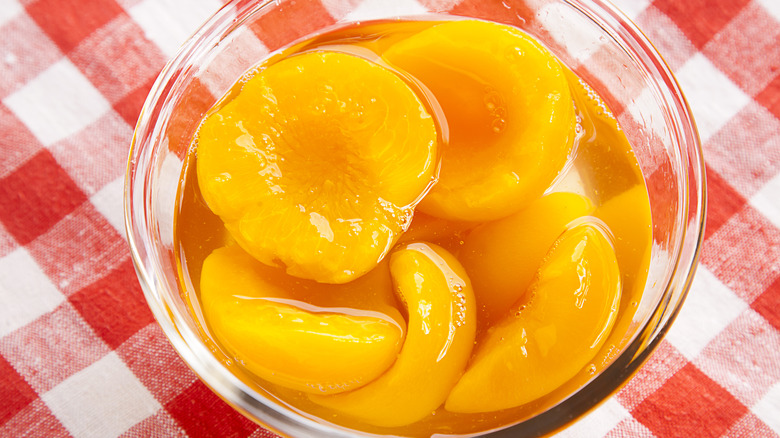Canned, Fresh, Or Frozen Peaches: Does It Matter For Your Cobbler Filling?
Nothing says summertime like warm peach cobbler on a lazy back-porch evening. The sun is setting, dinner is over, and the aroma of fresh, baked peaches lingers in the kitchen. It all feels so relaxing and effortless — unless, of course, you're the person tasked with making that perfect, iconic, eagerly anticipated cobbler. It's a simple dessert in many ways, a one-pan wonder requiring a handful of ingredients and a minimal time commitment. But expectations are extraordinarily high for this kickback king of summer royalty, so the pressure is on. That starts with the peaches.
Thousands of worldwide peach cobbler recipes exist, and many times more when counting its cousin, the easy peach crisp. You'll find the same conundrum throughout: Is it better to use fresh, frozen, or canned peaches, and does it really matter at all? Regardless of the type, they'll all be cooked to stewy deliciousness, along with white or brown sugar; maybe a bit of cinnamon, nutmeg, or even ginger; and a buttery biscuit-like topping. The texture of the peaches is mostly the same in the end, so it really comes down to cooking ease, peach availability, and whether or not there's a significant flavor difference. Here's a look at the three peachy contenders, though you'll likely consider them all viable options in their own ways.
Fresh peaches are the gold standard for a warm summer cobbler
When eating peaches on their own, there's no question about what's better tasting. The winner is freshly plucked peaches (as soon as possible after leaving the tree). The texture is miraculously soft, juicy, and crunchy at the same time, and the indescribable sweetness is something heavenly. In fact, Asian lore across the continent cloaks peaches in mystical properties of immortality, honor, happiness, and riches. How that translates into something more worldly like after-supper peach cobbler is a bit more practical.
The annual season for genuine fresh peaches is a relatively short one in the state of Georgia, which grows roughly 130 million pounds of peaches annually. They're available only from about mid-May until August. That's when peach orchards glow with soft orange hues, painting the landscape with edible art and thriving community spirit. About 40 peach varieties emerge from Georgia every year, many grown on multigenerational family farms. Obviously, scoring some in-season, fresh Georgia peaches is a dream-come-true for cobbler enthusiasts. Fresh versions arguably infuse peach cobblers, crisps, and crumbles with the most pristine flavors, unmatched by the frozen or canned renditions. We prefer to use fresh peaches in our classic peach cobbler recipe, sliced at a thickness of about ¼ inch. This allows them to cook fairly quickly along with the homemade biscuit-dough topping. However, if you must, frozen peaches will suffice in lieu of fresh ones.
Frozen peaches are ready for cobblers year-round
Besides the problematic fact that the growing season for fresh peaches is quite short, there are other reasons you might want to grab the frozen variety (in some ways, they're even preferable to freshly picked ones). It's no secret that keeping peaches fresh until ready for use can be challenging, being that they're grown commercially in relatively few states, including the top four of California, Georgia, South Carolina, and New Jersey. They're often picked early, requiring at-home countertop ripening. Plus, they're a fragile fruit, bruising easily with excess handling or transportation methods, which quickens deterioration.
That's at least one good reason to keep frozen peaches on hand for your favorite peach cobbler recipes. You also get the big advantage of ready-to-use fruit, with no peeling, pitting, and slicing involved. Choosing frozen peaches over fresh may seem like a compromise, but they're around when you need them, and they could be even more flavorful and nutritious than their field-fresh counterparts. That's because the taste and vitamins get locked in much quicker when frozen shortly after harvesting.
Freezing peaches yourself lets you gather as many of those luscious lovelies as possible while in season and store them for off-season access. Many available tutorials help you find the freezing method that suits your style, from blanching to flash freezing or sugar/syrup/water freezing. Alternatively, just pop whole peaches into freezer-compatible bags and defrost when sweet-peach cobbler cravings hit on a cold winter day.
Canned peaches make for a quick and easy cobbler
Georgia proudly bears a moniker of the Peach State, has a reported 70-plus streets named after the iconic fruit, and the wildly famous Peachtree Street runs through the capital of Atlanta. You'd think they know a few things about peaches, and they certainly do. That's why it's surprising that many canned-peach cobbler recipes dare to claim the name of a "Georgia peach cobbler." But there's a couple of big advantages to using the canned version, ones that even Georgia residents seem to embrace.
First of all, canned peaches allow you to bypass the surmised "summertime" nature of peach cobblers, instead letting them reign as fruit-dessert royalty in every season. Canned peaches are always available, relatively affordable, and ready in a snap with the help of a simple handheld can opener. But that's not all. The juice those peaches rest in can add a whole new dimension to peach cobblers. After draining it from the can and separating the peaches, save the juice for simmering on the stovetop, joined by sugar and cornstarch for a thick, sweet, cobbler filling. That said, Georgians are pretty relaxed about their recipes, so many recipes graciously make concessions for fresh, frozen, or canned peaches — whatever floats your boat, or your cobbler.



